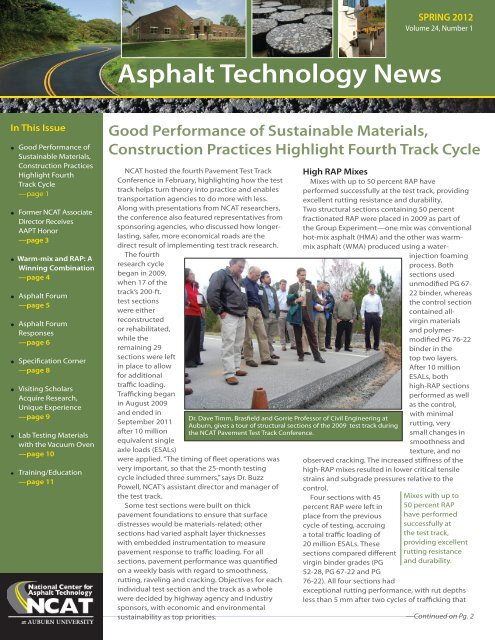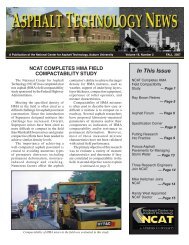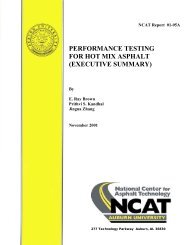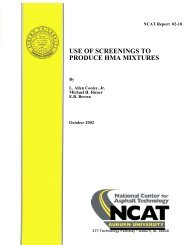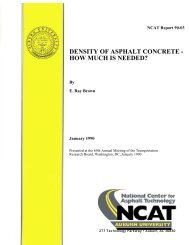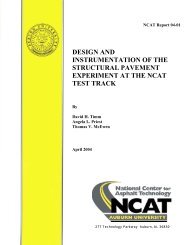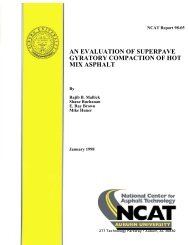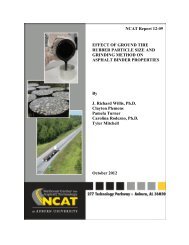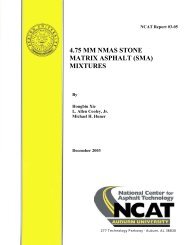Asphalt Technology News - National Center for Asphalt Technology
Asphalt Technology News - National Center for Asphalt Technology
Asphalt Technology News - National Center for Asphalt Technology
Create successful ePaper yourself
Turn your PDF publications into a flip-book with our unique Google optimized e-Paper software.
SPRING 2012Volume 24, Number 1<strong>Asphalt</strong> <strong>Technology</strong> <strong>News</strong>In This Issue• Good Per<strong>for</strong>mance ofSustainable Materials,Construction PracticesHighlight FourthTrack Cycle—page 1• Former NCAT AssociateDirector ReceivesAAPT Honor—page 3• Warm-mix and RAP: AWinning Combination—page 4• <strong>Asphalt</strong> Forum—page 5• <strong>Asphalt</strong> ForumResponses—page 6• Specification Corner—page 8• Visiting ScholarsAcquire Research,Unique Experience—page 9• Lab Testing Materialswith the Vacuum Oven—page 10• Training/Education—page 11Good Per<strong>for</strong>mance of Sustainable Materials,Construction Practices Highlight Fourth Track CycleNCAT hosted the fourth Pavement Test TrackConference in February, highlighting how the testtrack helps turn theory into practice and enablestransportation agencies to do more with less.Along with presentations from NCAT researchers,the conference also featured representatives fromsponsoring agencies, who discussed how longerlasting,safer, more economical roads are thedirect result of implementing test track research.The fourthresearch cyclebegan in 2009,when 17 of thetrack’s 200-ft.test sectionswere eitherreconstructedor rehabilitated,while theremaining 29sections were leftin place to allow<strong>for</strong> additionaltraffic loading.Trafficking beganin August 2009and ended inSeptember 2011after 10 millionequivalent singleaxle loads (ESALs)were applied. “The timing of fleet operations wasvery important, so that the 25-month testingcycle included three summers,” says Dr. BuzzPowell, NCAT’s assistant director and manager ofthe test track.Some test sections were built on thickpavement foundations to ensure that surfacedistresses would be materials-related; othersections had varied asphalt layer thicknesseswith embedded instrumentation to measurepavement response to traffic loading. For allsections, pavement per<strong>for</strong>mance was quantifiedon a weekly basis with regard to smoothness,rutting, raveling and cracking. Objectives <strong>for</strong> eachindividual test section and the track as a wholewere decided by highway agency and industrysponsors, with economic and environmentalsustainability as top priorities.Spring 2012 • Vol. 24 • No. 1High RAP MixesMixes with up to 50 percent RAP haveper<strong>for</strong>med successfully at the test track, providingexcellent rutting resistance and durability.Two structural sections containing 50 percentfractionated RAP were placed in 2009 as part ofthe Group Experiment—one mix was conventionalhot-mix asphalt (HMA) and the other was warmmixasphalt (WMA) produced using a waterinjectionfoamingprocess. Bothsections usedunmodified PG 67-22 binder, whereasthe control sectioncontained allvirginmaterialsand polymermodifiedPG 76-22binder in thetop two layers.After 10 millionESALs, bothhigh-RAP sectionsper<strong>for</strong>med as wellas the control,with minimalrutting, verysmall changes insmoothness andtexture, and noobserved cracking. The increased stiffness of thehigh-RAP mixes resulted in lower critical tensilestrains and subgrade pressures relative to theDr. Dave Timm, Brasfield and Gorrie Professor of Civil Engineering atAuburn, gives a tour of structural sections of the 2009 test track duringthe NCAT Pavement Test Track Conference.control.Four sections with 45percent RAP were left inplace from the previouscycle of testing, accruinga total traffic loading of20 million ESALs. Thesesections compared differentvirgin binder grades (PG52-28, PG 67-22 and PG76-22). All four sections hadMixes with up to50 percent RAPhave per<strong>for</strong>medsuccessfully atthe test track,providing excellentrutting resistanceand durability.exceptional rutting per<strong>for</strong>mance, with rut depthsless than 5 mm after two cycles of trafficking that—Continued on Pg. 21
—Continued from Pg. 1included some of the hottest recorded summers <strong>for</strong> the localarea. Mixes containing stiffer virgin binder grades exhibitedminor cracking at an earlier stage than mixes with softer binders,indicating that a softer virgin binder grade slightly improves thedurability of high-RAP mixes.In 2009, Mississippi DOT also sponsored a section containing45 percent RAP. While the mix used PG 67-22, early resultsindicate that per<strong>for</strong>mance is similar to an all-virgin mix withpolymer-modified PG 76-22. Significant cost savings canbe achieved by using high-RAP contents combined withunmodified binder.Warm-mix <strong>Asphalt</strong>In addition to the WMA test section with 50 percent RAP,two structural sections comparing WMA technologies—waterinjectionfoaming method and a chemical additive—werealso constructed at the test track as part of the 2009 GroupExperiment. After the application of 10 million ESALs, rut depthswere satisfactory in both WMA sections, though slightly higherthan in the control section, probably due to less binder agingand absorption during production. There were few practicaldifferences between the WMA sections and the control withregard to structural response, according to Dr. David Timm,Brasfield and Gorrie Professor of Civil Engineering at AuburnUniversity. No cracking was evident in either section, and lab testresults indicated greater fatigue life expectations <strong>for</strong> the WMAsections relative to the control.Alternative Binders and Binder ModifiersSeveral alternative binders and binder modifiers wereevaluated during the 2009 research cycle, investigating ways toreduce the quantity of asphalt materials needed <strong>for</strong> construction.Two options—Shell Thiopave, a warm-mix sulfur technology,and Trinidad Lake <strong>Asphalt</strong>, pelletized natural asphalt importedfrom Trinidad and Tobago—were successfully used as partialreplacements <strong>for</strong> refined liquid asphalt in three test sections.Kraton Polymers also sponsored a structural sectionincorporating highly polymer-modified (HPM) mixes that werevery stiff but strain-tolerant, allowing the test pavement to bedesigned with an 18 percent thinner cross-section. The excellentfatigue and rutting resistance observed in this section madeHPM the material of choice in rehabilitating a nearby pavementsection that was completely failed.Other experimental sections at the test track comparedbinder modification with ground tire rubber (GTR) and styrenebutadiene-styrene(SBS) polymer. Both laboratory testingand field measurements showed that mixes containing GTRper<strong>for</strong>med comparably to SBS mixes in every way.Porous Friction Courses and Stone Matrix <strong>Asphalt</strong>The benefits of porous friction courses (PFCs) includeimproved surface friction characteristics, reduced tire sprayduring rain events and reduced noise from tire/pavementinteraction. However, since the structural value of PFCs wasunknown, some states attributed no structural contribution atall to PFC layers. Embedded instrumentation at the test trackallowed <strong>for</strong> the structural characterization of a PFC section,indicating that PFCs do contribute to a pavement’s overallstructural integrity. A provisional structural coefficient of 0.15was determined <strong>for</strong> PFCs, allowing states to optimize pavementdesigns and make full use of available resources.As a rehabilitation surface in another section, PFC extendedthe per<strong>for</strong>mance life of underlying dense mix with a history ofcracking susceptibility. Per<strong>for</strong>mance was further improved whenthe PFC surface was placed with a heavy tack coat using a spraypaver compared with conventional tack methods.A 2009 section sponsored by Georgia DOT evaluated theuse of alternative aggregate sources <strong>for</strong> stone-matrix asphalt(SMA), a premium mix used on Georgia’s high-volume interstatehighways. The SMA test section contained a higher percentage offlat and elongated particles, yet had excellent per<strong>for</strong>mance withregard to rutting, cracking and raveling. These results indicatethat aggregate sources meeting Superpave specificationsper<strong>for</strong>m as well as the higher-cost cubical aggregate currentlyused <strong>for</strong> SMA in Georgia.Perpetual Pavements and Structural DesignTwo sections placed in 2003 that were designed to reachterminal serviceability at 10 million ESALs have survived animpressive 30 million ESALs at the test track. Both sections weredesigned using the 1993 AASHTO Pavement Design Guide,with an asphalt structural coefficient of 0.44 (the AlabamaDOT standard at the time). The sections differ with respect tobinder grade—one used PG 67-22, whereas the other usedSBS-modified PG 76-22. After 30 million ESALs, both sectionsexhibited minimal rutting and no fatigue cracking. These resultsindicate that pavements can withstand higher levels of strainResults indicatethat pavements canwithstand higherlevels of strain thansuggested by labtests, allowing thedesign of perpetualpavements withthinner cross-sectionsthat are more costcompetitive.than suggested by lab tests, allowingthe design of perpetual pavements withthinner cross-sections that are morecost-competitive.Recent research at the test track hasalso shown that the asphalt structuralcoefficient can be increased from 0.44 to0.54 <strong>for</strong> flexible pavement designs usingthe 1993 AASHTO Pavement DesignGuide. The coefficient recalibrationwas based on structural measurementsfrom test sections with a broad rangeof asphalt thicknesses and mix types, aswell as different bases and subgrades. Increasing the coefficientto 0.54 results in approximately 18 percent thinner asphalt crosssections.Alabama DOT estimates savings of approximately $40million per year since implementing the revised layer coefficient.MEPDG Predictions vs. Actual Per<strong>for</strong>mancePer<strong>for</strong>mance data from the 2003 and 2006 structural sectionsat the test track were compared with per<strong>for</strong>mance predictionsusing the Mechanistic-Empirical Pavement Design Guide(MEPDG). Using the national calibration coefficients generallyover-predicted rutting. However, newly calibrated coefficients—Continued on Pg. 32<strong>Asphalt</strong> <strong>Technology</strong> <strong>News</strong>
Former NCAT Associate Director Receives AAPT HonorPrithvi (Ken) Kandhal, associatedirector emeritus of NCAT, recentlyreceived honorary membership inthe Association of <strong>Asphalt</strong> PavingTechnologists (AAPT). This honorcomes after 40 years of work inthe AAPT and the field of asphaltpavement design and construction.NCAT Director Emeritus Dr. RayBrown, who nominated Kandhal <strong>for</strong>the award, says Kandhal’s involvementand leadership in the AAPT and“helped advance AAPT’s reputation tothe preemiment organization itis today.”Kandhal also contributed a greatdeal to NCAT during his time asassistant director and, later, associatedirector. He is one of the key authorsof the NCAT textbook Hot Mix <strong>Asphalt</strong>Materials, Mix Design, and Construction, and he was a primaryinstructor and course designer <strong>for</strong> the internationally renownedNCAT Professor Training Course.Prithvi (Ken) Kandhal (right) receives his NCAT Wall ofHonor plaque from NCAT Director Randy West in Aug.2011. Kandhal has made many contributions to bothNCAT and the AAPT.In 1998, he launched <strong>Asphalt</strong><strong>Technology</strong> <strong>News</strong>, NCAT’s biannualnewsletter and continued to produce thepublication until his retirement. Today,the newsletter is one of the center’smain outlets <strong>for</strong> disseminating NCATresearch and other relevant news, aswell as a <strong>for</strong>um <strong>for</strong> highway agencies toshare specifications, suggestions andquestions related to asphalt pavements.Kandhal’s significant research andoutreach contributions during his 13years at NCAT earned him the title ofassociate director emeritus upon hisretirement. He is also part of the NCATWall of Honor, established in 2011 aspart of the center’s 25th anniversarycelebration.The India native’s interest in asphaltpavements began in his homecountry, where he was introduced to asphalt as a highwayagency engineer.—Continued on Pg. 5—Continued from Pg. 2<strong>for</strong> the unbound layers produced acceptable rutting predictions.Fatigue cracking predictions were unsuccessful, with pooragreement between measured and predicted per<strong>for</strong>manceregardless of the coefficients used. Grouping sections withsimilar characteristics may result in better fatigue calibrationresults, an approach that may be helpful in analyzing data <strong>for</strong> the2009 sections.Research at the test track is also contributing to furtherunderstanding of laboratory per<strong>for</strong>mance tests and modelingpredictions. The NCAT lab has conducted extensive testingon the mixes from the test sections, and researchers havecarefully analyzed data using both the conventional pavementdesign approach and mechanistic-based methods. One of thekey findings is that some of the tests used to assess crackingper<strong>for</strong>mance use unrealistic strain levels that result in differentper<strong>for</strong>mance rankings compared to observations in the field.This is especially relevant in the characterization of high-RAPcontent mixes.The focus of research <strong>for</strong> the test track’s fifth cycle, scheduled tobegin this summer, will be exploring ways to help transportationdollars go further. A number of sections from the fourth cycle,including the WMA and 50 percent RAP sections, will likelyremain in place <strong>for</strong> further trafficking as part of the PreservationGroup experiment. Pavement preservation treatments (e.g.,thin overlays and inlays, microsurfacing, chip seals, and othersurface treatments) will be applied when a predetermined levelof distress is reached. Further per<strong>for</strong>mance monitoring will allowresearchers to determine the life-cycle cost of various pavementpreservation alternatives relative to pretreatment condition.Preservation treatments will also be applied to a local countyroad that provides access to a quarry and asphalt productionfacility. The existing pavement condition varies from good topoor. This study will expand the scope of testing on the test trackinto a “proactive versus reactive” experiment that defines therelationship between life-cycle per<strong>for</strong>mance and pretreatmentcondition <strong>for</strong> popular preservation alternatives.Multiple sponsors will also be participating in the GreenGroup, which will be constructed this summer using highrecycled contents—both RAP and recycled asphalt shingles(RAS)—in addition to unconventional materials and alternativedesign methodologies. The goal will be to assist states withimplementation of these green technologies that have thepotential to reduce initial construction cost, pavement thicknessand environmental impact.There are many sponsorship options available at the NCATPavement Test Track. For more in<strong>for</strong>mation, go to www.pooledfund.org/Details/Solicitation/1325 or contact Dr. BuzzPowell at 334.844.6857.Spring 2012 • Vol. 24 • No. 13
Warm-mix and RAP: A Winning CombinationUsing warm-mix asphalt (WMA) technologies in recycledasphalt pavement (RAP) mixes is a win-win scenario in everyrespect. The cost benefits are evident—reduced materialcosts and less fuel usage. Plus, the enhanced workability ofwarm-mix can facilitate using increased RAP contents, whichtranslates into even greater cost savings. With sustainableadvantages such as conserving natural resources and reducingthe emission of greenhouse gases, the WMA/RAP combinationalso scores high in terms of environmental stewardship.Beyond economic and environmental benefits, WMA andRAP together create a synergistic mixture. “They go together,like peanut butter and jelly or macaroni and cheese,” says Dr.Randy West, NCAT director. “We should be using them togetherwhenever we can.”A RAP mixproduced atwarm-mixtemperaturesshould haveample stiffnessto resistrutting, as wellas sufficientviscoelasticbehavior toresist cracking.Combining WMA and RAP offers potentialimprovements in pavement per<strong>for</strong>mancecompared to using either alone. AASHTOM320 recommends using a softer virginbinder grade <strong>for</strong> moderate and high (greaterthan 25 percent) RAP contents. Addingwarm-mix is the perfect solution, as lowermixing temperatures result in less binderaging during production and, consequently,a softer binder. A RAP mix produced atwarm-mix temperatures should then haveample stiffness to resist rutting, as well assufficient viscoelastic behavior to resistcracking.Plant operations are also improved whenWMA and RAP are used together. Plant concerns associatedwith warm-mix include possible incomplete aggregate dryingin the drum. Also, when the gas temperature in the baghouse isreduced below the vapor point of water, muddling of the bagscan occur. However, these concerns are alleviated with theuse of RAP, since aggregate is superheated to compensate <strong>for</strong>adding RAP at ambient temperatures. Producing RAP mixes atwarm-mix temperatures also eliminates blue smoke emissions.As part of the 2009 Group Experiment at the NCAT PavementTest Track, two full-depth 50 percent RAP sections wereplaced—one produced as WMA using the water-injectionfoaming method and the other as HMA. Each 7-inch structuralsection included 50 percent fractionated RAP in all three liftsof the asphalt cross-section. Each section used PG 67-22 virginbinder, whereas the control incorporated PG 76-22 binderin the surface and intermediate lifts and all-virgin materialsthroughout.After the application of 10 million equivalent single-axle loads(ESALs), the high-RAP WMA section per<strong>for</strong>med as well as thecontrol. No cracking was observed in any of the three sections,and all three exhibited excellent rut resistance. As shown inTable 1, less rutting was seen in the high-RAP WMA sectionthan in the control. Table 1 also shows that changes in texturewere very low <strong>for</strong> the high-RAP and control sections, indicatingexcellent durability.Table 1 Final Rut Depths and Texture ChangesTestSectionDescriptionFinal WireLine RutDepthMeanTextureDepthChangeS9 Control 7.1 mm 0.227 mmN11 50% RAP WMA 3.7 mm 0.189 mmN10 50% RAP HMA 1.8 mm 0.178 mm1Texture changes were normalized to Mean Texture Depth at 500,000 ESALsTwo all-virgin WMA sections, one produced using the waterinjectionfoaming process and one with a chemical additive,were also tested in the 2009 Group Experiment at the testtrack. While the rutting per<strong>for</strong>mance of both WMA sectionswas satisfactory, the rutting per<strong>for</strong>mance of the 50 percent RAPWMA section was significantly better.Deflection testing confirmed that the 50 percent RAP sections(both HMA and WMA) were stiffer than the control. As a resultof this increased stiffness, measured strain levels were lower inthe high-RAP sections than in the control, particularly at warmertemperatures. Laboratory fatigue testing also indicated thatthe endurance limit <strong>for</strong> the RAP-WMA section was significantlyhigher than the control.As demonstrated at the NCAT Pavement Test Track, WMAand RAP together create a synergistic mixture that offersimprovements in pavement per<strong>for</strong>mance and plant operations,as well as significant cost savings and environmental benefits.WMA/RAP is simply a winning combination.WMA/RAP Field Per<strong>for</strong>mance at the Test TrackSection N11 at the NCA T Pavement Test Track, shown above,is a warm-mix asphalt section made with 50 percentreclaimed asphalt pavement.4<strong>Asphalt</strong> <strong>Technology</strong> <strong>News</strong>
<strong>Asphalt</strong> ForumNCAT invites your comments and questions, which may be submitted to Karen Hunley at karen.hunley@auburn.edu.Questions and responses are published in each issue of <strong>Asphalt</strong> <strong>Technology</strong> <strong>News</strong> with editing <strong>for</strong> consistency andspace limitations.Greg Sholar, Florida DOTWhat lift thickness is optimal <strong>for</strong> SP-4.75 mixtures? What thicknesswould be considered too thin <strong>for</strong> good paving practices?Is there a maximum thickness where rutting becomes an issue?What binder grade is being used in this mix type?Don Watson, NCATWhat practices have agencies successfully used to preventreflective cracking?There seems to be growing interest in recycled asphalt shingles(RAS), but are agencies actually seeing an increase in shinglerecycling? Are there different handling procedures or mix designguidelines <strong>for</strong> tear-offs than <strong>for</strong> manufacturing rejects, since tearoffsare much stiffer?There is renewed interest in the use of ground tire rubber (GTR).What mesh-size particles have worked best and in whatproportions?What are some of your agency’s priority needs in the area ofasphalt research?What challenges do you <strong>for</strong>esee regarding work<strong>for</strong>ceenlistment and development?Denis Boisvert, New Hampshire DOTNew Hampshire’s experience with warm-mix asphalt (WMA)to date has been favorable. Our specification is of a permissivenature, so most contractors are opting <strong>for</strong> foaming technologiessince they cost less. They are mainly interested in the compactionaid over the fuel savings.We specified three WMA projects within our maintenance districtoverlay program, requiring temperatures that were lower thanthe foaming technologies are capable of to <strong>for</strong>ce the contractorsto try the new technologies. All projects were completed with achemical additive, that being the easiest to implement withoutcommitting capital investment. Both DOT and contractors werepleased and excited with the results.Dale Rand, Texas DOTWe recently completed some in-house research on a porous frictioncourse (PFC) mix with shingles to see if we could eliminatethe use of additional fibers. When using up to 5 percent RAS, wewere not able to get anything to pass the drain-down test unlessadditional fibers were added. We concluded that the amount offibers could be reduced but not eliminated when using RAS inPFC mixes.Former NCAT Associate Director Receives AAPT Honor—Continued from Pg. 3“While working in a dry desert region of India with no stonequarries, I successfully experimented with road constructionusing dune sand and asphalt,” Kandhal“Receivinghonorarymembership inAAPT is a proudmoment in mylife, especiallywhen it is beingaccorded by mypeers from allcontinents ofthe world.”-Ken Kandhaladds. “That is when I started tolove asphalt.”He later moved to the U.S. and receivedhis master’s degree in civil engineering fromIowa State University. After graduation,he spent 18 years at the PennsylvaniaDepartment of Transportation as the chiefasphalt engineer. Kandhal arrived at NCATin 1988.Some of his notable researchaccomplishments at both the PennsylvaniaDOT and NCAT include work related to theSuperpave restricted zone, stripping ofasphalt pavements, per<strong>for</strong>mance testingof HMA mixtures, construction guidance <strong>for</strong> longitudinal joints,tests to determine bulk specific gravity of fine aggregates andaggregate tests related to HMA per<strong>for</strong>mance.Throughout his career, Kandhal has published more than 120articles in technical journals, as well as trade magazine articles,conference proceedings and more than 20 AAPT technicalreports. In 1989, he received the prestigious W. J. Emmons Award<strong>for</strong> the best paper presented and published by the AAPT. Thispaper summarized his research on moisture susceptibility ofasphalt mixtures.Kandhal also directly helped increase AAPT membershipduring his term as AAPT president from 1999-2000. He wrotepersonal letters to all AAPT conference attendees that year,thanking them <strong>for</strong> their attendance and encouraging them tojoin the organization.In addition, he has been active in several other technicalsocieties and organizations, such as the Transportation ResearchBoard (TRB), the American Society <strong>for</strong> Testing and Materials(ASTM), and the American Society of Civil Engineers (ASCE).Khandal officially received his honorary membership at a<strong>for</strong>mal banquet on April 3 during the AAPT annual meeting inAustin, Texas.“Receiving honorary membership in AAPT is a proud momentin my life, especially when it is being accorded by my peers fromall continents of the world,” Kandhal says.Spring 2012 • Vol. 24 • No. 15
Specification CornerFloridaA new specification requirement has been issued related tosegregation in dense-graded mixtures. For visually identifiedsegregated areas, cores will be obtained and measured <strong>for</strong>in-place density. Areas having a density less than 90 percentGmm will have to be removed and replaced.TennesseeThe Tennessee DOT recently tightened its productiontolerance <strong>for</strong> 100 percent pay on asphalt content (AC) from0.4 to 0.3 percent. Warm-mix asphalt is now permitted on anyawarded TDOT project. Lastly, the minimum total AC content<strong>for</strong> 411-D, TDOT’s standard 12.5-mm nominal maximumaggregate size (NMAS) surface mixture, has been raised from5.3 to 5.7 percent.MissouriIn April 2011, the Missouri DOT changed the binderspecification, Section 1015, to include an option to producebinder in accordance with AASHTO MP 19. About three yearsago, we added a special provision that allowed modificationof binders using ground tire rubber (GTR) cross-linked withtranspolyoctenamer rubber (TOR) with multiple stress creeprecovery (MSCR) as an option to elastic recovery that requirespolymer modification. Sections S6 and S7 of the 2009 cycleon the NCAT test track include a comparison of mixtureswith SBS and GTR modification. Excellent per<strong>for</strong>mance of theGTR-modified mixture after 18 months allowed us to moveahead and add GTR modification to the Missouri StandardSpecifications. In doing so, we elected to offer the option ofMP 19 <strong>for</strong> any binder. We allow PG 64-22, and Grade H andGrade V in lieu of PG 70-22 and PG 76-22, respectively. Mostpolymer-modified binders are now being supplied usingthe MP 19 protocols due to <strong>for</strong>mulation changes that allowsuppliers to manufacture the binders at a lower cost.Three projects are under contract to use permeability asthe measure of density. Two are completed, and the otherwill be completed in the first half of 2012. The falling headpermeameter developed under NCAT Report 99-01 is usedas the testing device. One of the basic objectives of densitymeasurements is to produce a long-lasting, somewhatimpermeable pavement. Each mixture by its compositionhas a particular point of reaching impermeability. Designingmixtures with permeability in mind will hopefully reducethe compactive ef<strong>for</strong>t required <strong>for</strong> placement. By measuringpermeability, the goals are to reduce permeability inMissouri’s pavements and provide an accurate nondestructivetest. The projects completed so far also usedcores <strong>for</strong> density measurements and indicate the pay factors<strong>for</strong> either method are roughly equivalent. It has been foundthat fresh plumber’s putty provides a consistent, satisfactoryseal with this method.New HampshireOur quality control/quality assurance (QC/QA) specificationhas been revised to shift emphasis from thickness to crossslope. It was a small pay-factor change intended to promotemaintenance of our roadway crown, which we observe isdiminishing from repeated overlay projects.We have added a milling tolerance <strong>for</strong> mill-and-fill projects.The specification <strong>for</strong>ces good milling equipment maintenance.Some contractors do not replace milling teeth uni<strong>for</strong>mly orfrequently enough to create an evenly milled surface. This cancause uneven depths between individual passes.Language has been added to specifically allow warm-mixasphalt (WMA) technologies. This has been done by referenceto a Qualified WMA Technologies List, which is essentially theNorthEast <strong>Asphalt</strong> Users Producers Group (NEAUPG) qualifiedtechnologies list. Sections of our specification have beenrevised to allow lower minimum deliver and mat temperatureswhen WMA technologies are in use.TexasThe Texas DOT will be implementing new HMA specificationswithin the next few months. All the HMA specificationshave been rewritten in order to improve the quality of ourHMA pavements, reduce cost and be better stewards ofthe environment. The use of reclaimed asphalt pavement(RAP), reclaimed asphalt shingles (RAS), WMA and “substitutebinders” is permitted in most of our new specifications.We have also put more incentive into our specifications <strong>for</strong>contractors to use the Paver-IR system on paving projects. Inaddition, we have implemented a system of using securitybags to maintain custody of samples when the samples arenot within Texas DOT’s custody prior to testing. This was doneto address the FHWA’s concern regarding sample custody.Stone-matrix asphalt (SMA) mixes will now be required to passthe overlay test (min. 300 cycles) prior to use.Our new permeable friction course (PFC) specificationincludes a mix with a smaller nominal aggregate size as oneof the options. This fine PFC mix will typically be placed in the0.75- to 1.0-inch thickness range.Need RAS Testing?The NCAT laboratory can meet all your needs<strong>for</strong> recycled asphalt shingles (RAS) testing:• Gradation of RAS• <strong>Asphalt</strong> BinderContent of RAS• Per<strong>for</strong>mance Gradingof RAS Binder• Deleterious Materials• Asbestos Testing UsingPolarized LightMicroscopyCall Jason Moore at 334.844.7336<strong>for</strong> more in<strong>for</strong>mation.8<strong>Asphalt</strong> <strong>Technology</strong> <strong>News</strong>
Visiting Scholars Acquire Research, Unique ExperienceWhen Dr. Flavio Padula graciously describes his experienceas an NCAT visiting scholar as “perfect,” he is referringto both his work at NCAT and his family’s quality of lifein Auburn.“Besides all the great opportunities that I was given atNCAT, coming to the U.S. was also a wonderful event <strong>for</strong> meand my family,” Padula said. “We really enjoyed Auburn andAmerican people.” Padula, who finished his time at NCAT inDecember 2011, is a civil engineering professor from Brazil.He is one of about 20 international visiting scholars NCAThas hosted since its inception in 1986. These scholars aretypically professors or engineering professionals who receivea grant from their government to learn more aboutasphalt technologies. They are selected on a case-by-casebasis and stay here about six to 12 months.NCAT has hosted visiting scholars from Africa, Indonesia,Japan, China and Pakistan. The first scholar was African nativeBadru Kiggundu, who arrived at NCAT in 1989.Since NCAT does not yet have a <strong>for</strong>mal program <strong>for</strong> visitingscholars, the center cannot provide them any financialsupport <strong>for</strong> living expenses. However, scholars like Padulafeel that the opportunity to work at a nationally renownedasphalt research facility is a fair exchange <strong>for</strong> paying theirown way.Sharing Knowledge“As a professor, the knowledge gained at NCAT will be disseminatedto students and researchers, and will benefit thecitizens of Brazil,” Padula says. He is especially excited aboutpassing along what he’s learned about recycling asphaltmaterials, as he says the Brazilian government does not currentlyhave any guidelines or programs relating to pavementmaterials recycling.During his one-year stay, Padula attended five trainingcourses, including the annual Professor“As a professor,the knowledgegained at NCATwill bedisseminated tostudents andresearchers, andwill benefit thecitizens of Brazil.”-Flavio PadulaTraining Course; participated in threeresearch projects; assisted with qualitycontrol during a field project; wrote fiveresearch papers; and ran several lab tests.Padula says he most enjoyed NCAT’s idealcombination of theory and practice.“I was able to learn many things in theory,and then see the practice by goingto the NCAT test track and constructionsites,” he says. “The fact that NCAT hasa partnership with state DOTs and theasphalt industry—together with the labDr. Flavio Padula from Brazil (left) and Dr. Gongyun Liao from China (right)botrecently completed their time as visiting scholars at NCAT.and track—is the key to the success of NCAT.”Dr. Gongyun Liao, a visiting scholar from Southeast Universityin Nanjing, China, said that the test track and its acceleratedtesting capability was the main draw to NCAT <strong>for</strong> him. He worksin the field of pavement noise.“The full database of noise data measured at the test trackand corresponding pavement surface measurements will provideme a chance to evaluate the relative significance of pavementsurface characteristics on noise,” Liao says. “This may be a strongbase <strong>for</strong> future low-noise asphalt pavement design.”He also says that the “working style and management methodsat NCAT” will greatly influence his teaching style and researchendeavors when he returns to Southeast University.Benefits on Both SidesDr. Ray Brown, director of NCAT from 1991-2007, said thatvisiting scholars benefit NCAT as well, explaining that they are“good <strong>for</strong> our international reputation” and also contribute usefulresearch. NCAT often receives international graduate students asa result of the visiting scholars going home and discussing theirexperience here.For Padula, sharing his experience will almost certainly meantalking about his family’s daily activities in Auburn, in addition todiscussing his NCAT research. He and his wife especially appreciatedthat their 5-year-old daughter was able to attend kindergarten<strong>for</strong> free in the prestigious Auburn City Schools system, and hementioned how safe and com<strong>for</strong>table they felt in Auburn.Living and studying in the U.S. also meant that both Padula andLiao had to face one of their greatest challenges – improving theirEnglish-speaking skills. While he studied English in Brazil, Padulasays the accents and colloquialisms here made learning the languagemuch more difficult. But he received help in this area froman unexpected source.“My daughter is now teaching us English, after being in schoolhere,” Padula says. “This was a great opportunity <strong>for</strong> us to improveour English skills and learn about the American culture.”Spring 2012 • Vol. 24 • No. 19
Lab Testing Materials with the Vacuum OvenTesting asphalt pavement materials such as aggregate, reclaimedasphalt pavement (RAP) and mixture specimens oftenrequires that samples be dried to a constant mass. Most labsaccomplish this using convection ovens or fan drying, dependingon sample type. The <strong>National</strong> <strong>Center</strong> <strong>for</strong> <strong>Asphalt</strong> <strong>Technology</strong>(NCAT) recently completed a study to determine if vacuum ovensare an economically feasible alternative to convection ovens andfan drying in an asphalt pavement lab. The underlying premiseof a vacuum oven is that at low pressures, water converts tosteam at a much lower temperature, which should enable moreefficient drying.MethodologyThe cost of the vacuum oven used in this study was approximatelytwice that of a standard convection oven of similar size.Circular holes were drilled into the shelves to better facilitateair flow and moisture drainage within the vacuum oven. Per themanufacturer’s instructions, the vacuum line was closed oncetarget pressure (26-27 atm below atmospheric pressure) was appliedin order to preventmoisture damage to thevacuum pump.The vacuum ovenwas evaluated relativeto conventional dryingmethods <strong>for</strong> threeclasses of materials:aggregate, recycledasphalt materials andcompacted HMA specimens.Six aggregatematerials, representingVacuum oven .both coarse- and finegradedstockpiles with arange of absorption values, were included in the study. Recycledmaterials included both coarse- and fine-graded RAP, as well asrecycled asphalt shingles (RAS). All aggregate and recycled materialsamples were wetted by adding distilled water (2 percent byweight Honoree <strong>for</strong> Mike coarse Acott materials accepts his and Wall 6 percent <strong>for</strong> fine) and dried at110°C of Honor in both plaque vacuum from NCAT and DirectorRandy West.convection ovens.Compacted HMA specimens were also used to evaluate theper<strong>for</strong>mance of the vacuum oven. Samples represented three differentspecimen geometries used <strong>for</strong> common lab per<strong>for</strong>mancetests: dynamic modulus and flow number using the <strong>Asphalt</strong> MixturePer<strong>for</strong>mance Tester (AMPT), the Hamburg Wheel-TrackingTest, and creep compliance and indirect tensile strength (IDT).All samples were prepared using the same plant-produced 12.5mm Superpave mix and compacted to 7.0 ± 1.0 percent air voids.All compacted specimens were submerged <strong>for</strong> four minutes(according to AASHTO T166) and dried to a saturated surface-dry(SSD) condition prior to vacuum oven or fan drying. To minimizesample aging, the vacuum oven temperature was set at 40°C.For each material, the average drying time was defined as thetime of measurement beyond which no more than 0.1 percentsample mass was lost, per AASHTO T255-00. Average dryingFigure 1 Average drying time <strong>for</strong> fine aggregate—vacuumoven vs. conventional oven drying.time <strong>for</strong> each material was used to determine if the vacuum ovenper<strong>for</strong>med better than conventional drying methods. Figure 1shows an example of the data generated during the experiment.ResultsFor the majority of aggregate materials tested, the vacuumoven did not result in faster dry times than the conventionaloven. The one exception was low-absorption, coarse, roundedgravel. Theoretically, the vacuum oven should be effective onhighly absorptive materials with extensive pore space, but thesedata did not support this theory.The vacuum oven provided only a slight drying benefit <strong>for</strong>the RAS material, which is considered minimally absorptive, andnone <strong>for</strong> the coarse and fine RAP. Again, the only drying benefitwith the vacuum oven was observed <strong>for</strong> low-absorption material.However, RAS is fine-graded, whereas in the aggregate evaluationthe drying benefit was observed only with a coarse-gradedaggregate. Thus, there appears to be no correlation betweengradation and vacuum oven effectiveness.With the compacted HMA specimens, the vacuum ovenshowed an improvement in the rate of drying versus fan drying.However, a comparison was not made between thevacuum oven and a conventional oven set to a low temperature<strong>for</strong> drying compacted HMA samples. It is also unknown whetheroven drying would detrimentally age compacted per<strong>for</strong>mancespecimens.Additional TestingDuring the course of vacuum oven testing, large amounts ofmoisture evaporated from samples and re-condensed inside thevacuum oven chamber. Since the condensed moisture was unableto escape the sealed chamber, the samples were being driedin a high-moisture environment, which could be a reason why—Continued on Pg. 1110<strong>Asphalt</strong> <strong>Technology</strong> <strong>News</strong>
Education and TrainingNCAT offers a variety of training opportunities to fit your needs. To register <strong>for</strong> a class or <strong>for</strong> more in<strong>for</strong>mation,please visit our website at www.ncat.us or call Don Watson at 334.844.7306.New Course Focuses on WMA, RAP and RASInterest in using warm-mix asphalt (WMA), reclaimed asphaltpavement (RAP) and reclaimed asphalt shingles (RAS) hasincreased in recent years due to rising construction costs andef<strong>for</strong>ts toward sustainability within the asphalt pavementindustry. With this interest,however, comes the need<strong>for</strong> training on best practices<strong>for</strong> designing asphalt pavingmixtures that include WMA,RAP and/or RAS.NCAT began offering a newtraining course in January2012 to address this need.Advanced Mix Design: WMA,RAP and RAS is a threedaycourse that providesin<strong>for</strong>mation on testing,per<strong>for</strong>mance and cost <strong>for</strong>each of these processes. Threecourses have been held so far,with a total of 38 participants,and one more course isscheduled April 17-19.“The course is needed atNCAT because these are threenew areas (WMA, high RAP and RAS) that have created a lot ofexcitement in the industry, and we are seeing a rapid increasein their use,” says Dr. Ray Brown, director emeritus of NCAT, whohelped create the course.He also said it’s important that the industry learns from thoseinvolved in previous and existing projects with WMA, RAP andRAS “so that we can minimize any mistakes and ensure betterper<strong>for</strong>mance on future projects.”NCAT engineer Grant Julian, an instructor in the Advanced MixDesign course, shows participant Chris Counce how to use the warmmixasphalt foamer during a laboratory demonstration.The course includes lectures, laboratory demonstrations,hands-on training, and an optional tour of high RAP and WMAsections at the NCAT Pavement Test Track. The lectures focus ontopics such as sources of RAP and RAS, mix design procedures,overview of WMA technologies,guidance <strong>for</strong> field quality control/quality assurance, observedper<strong>for</strong>mance of high RAP/RASand WMA mixes, economicanalyses and proposed guidespecifications.In the laboratory, studentshave the opportunity to handlevarious WMA technologies,observe per<strong>for</strong>mance testequipment operation, andobserve mix design andmaterials testing.In the first three courses,attendees from state highwayagencies have indicated thatit is valuable to hear whatneighboring states are doing inthe three areas.“There is not a lot of experiencewith mix design and production of RAS and, hence, attendeesfeel like the discussion about production procedures andobserved problem areas have been very helpful,” Brown says.Material producers, contractors, consultants and highwayagency personnel may be interested in this NCAT course. Formore in<strong>for</strong>mation, visit http://www.ncat.us/education or callDon Watson at 334.844.7306.—Continued from Pg. 10the vacuum oven was ineffective in drying most aggregate andrecycled asphalt materials. Two modified procedures were testedin an ef<strong>for</strong>t to address this problem.First, a large container of desiccant was placed on the vacuumline, allowing the line to remain open during drying. As theescaping moisture was pulled through the vacuum line, it wastrapped in the desiccant be<strong>for</strong>e it could damage the pump. Thehigh-absorption coarse and fine aggregates were re-tested usingthis retrofit. While the desiccant was effective in removingmoisture, it became saturated quickly and this procedure did notresult in an appreciable improvement in drying time.A second modified procedure involved re-testing the high-ab-sorption aggregates at ambient temperature, using only vacuumpressure to remove moisture from the materials. This modificationwas also not effective in reducing drying time.ConclusionsThe vacuum oven did not improve the drying rate <strong>for</strong> aggregateand recycled asphalt materials, except <strong>for</strong> those with thelowest absorption values. While the vacuum oven did offer animprovement in drying time <strong>for</strong> compacted HMA samples comparedto fan drying, questions remain regarding this practice.Thus, the per<strong>for</strong>mance of the vacuum oven does not warrant itsadditional cost relative to conventional lab drying equipment.Spring 2012 • Vol. 24 • No. 111
ncat.usAuburn University is an equal opportunity educational institution/employer.ENN1104NT1735 Extension Loop, Auburn, AL 36849-7350Nonprofit Org.U.S. PostagePAIDPermit #9Auburn, AL 36849<strong>National</strong> <strong>Center</strong> <strong>for</strong> <strong>Asphalt</strong> <strong>Technology</strong>,277 <strong>Technology</strong> Parkway, Auburn, Alabama 36830-0550Phone: 334 • 844 • NCAT (6228) Fax: 334 • 844 • 6248Randy West, Director, NCATKaren Hunley, Editor, NCATCourtney Jones, Writer, NCATCheryl Cobb, Associate Editor, College of EngineeringASPHALT TECHNOLOGY NEWS (Library of Congress Catalog No. ISSN 1083-687X)is published by the <strong>National</strong> <strong>Center</strong> <strong>for</strong> <strong>Asphalt</strong> <strong>Technology</strong> (NCAT) of Auburn University. Its purposeis to facilitate the exchange and dissemination of in<strong>for</strong>mation about hot mix asphalt technology,trends, developments and concerns. Opinions expressed in this publication by contributorsand editors, the mention of brand names, the inclusion of research results, and the interpretationof those results do not imply endorsement or reflect the official positions or policies of NCAT orAuburn University.12<strong>Asphalt</strong> <strong>Technology</strong> <strong>News</strong>


